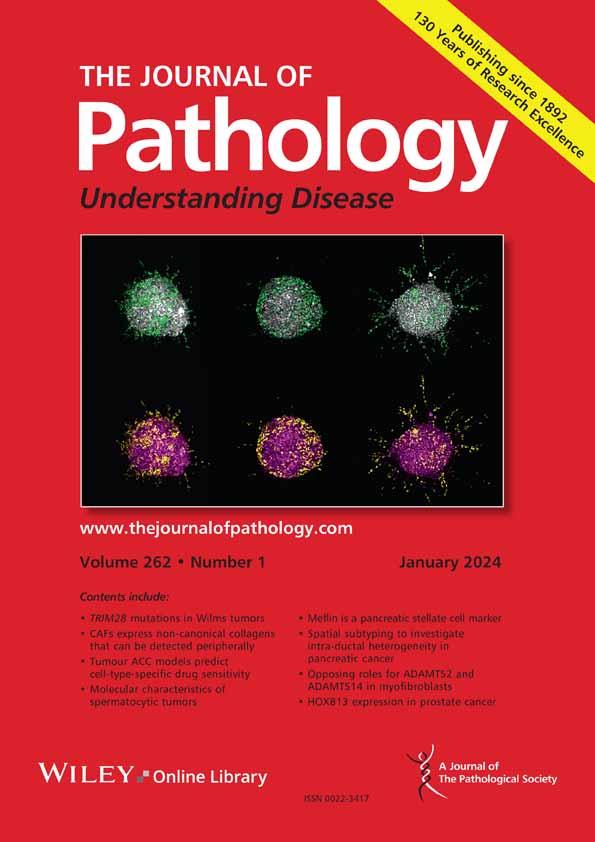Paola Defilippi, Francesca Nigrelli, Pietro Arina, Daniela Taverna, Vincenzo Salemme
下载PDF
{"title":"一种富含腔内(ER+)肿瘤和年轻绝经前患者的乳腺癌PDX集合,以确定高风险患者的新治疗策略","authors":"Paola Defilippi, Francesca Nigrelli, Pietro Arina, Daniela Taverna, Vincenzo Salemme","doi":"10.1002/path.6418","DOIUrl":null,"url":null,"abstract":"<p>Breast cancer includes a group of neoplasms originating from mammary gland epithelial cells caused by a variety of genetic alterations, with different responses to treatments and outcomes. In clinical practice, estrogen receptor (ER), progesterone receptor (PR), and human epidermal growth factor receptor 2 (HER2) expression guides the distinction between luminal A (ER<sup>+</sup>, PR<sup>+</sup>, HER2<sup>−</sup>), luminal B (ER<sup>+</sup>, PR<sup>+</sup>, HER2<sup>+/−</sup>), and triple-negative (ER<sup>−</sup>, PR<sup>−</sup>, HER2<sup>−</sup>), each with a distinct biological behavior and clinical and therapeutic implications. Approximately 11% of breast cancers are diagnosed in young premenopausal women aged 20–49 years. Patient-derived xenografts (PDXs) offer a powerful solution to integrate personalized medicine and novel therapeutic agents. Dr Belletti's group recently developed a PDX biobank composed of 26 PDX lines highly enriched in luminal A and B and young premenopausal breast cancer patients. The bank faithfully recapitulates the characteristics of the original tumors. A major focus of their research was to exploit these PDXs to assess the resistance to CDK4/6 inhibitors (CDK4/6i), which are critical in managing advanced luminal breast cancers. Their effort addresses a significant gap in existing PDX models, which are limited for these patient subgroups, thereby enabling deeper insights into tumor biology and therapeutic responses in these understudied populations. © 2025 The Author(s). <i>The Journal of Pathology</i> published by John Wiley & Sons Ltd on behalf of The Pathological Society of Great Britain and Ireland.</p>","PeriodicalId":232,"journal":{"name":"The Journal of Pathology","volume":"266 2","pages":"125-129"},"PeriodicalIF":5.2000,"publicationDate":"2025-03-27","publicationTypes":"Journal Article","fieldsOfStudy":null,"isOpenAccess":false,"openAccessPdf":"https://onlinelibrary.wiley.com/doi/epdf/10.1002/path.6418","citationCount":"0","resultStr":"{\"title\":\"A breast cancer PDX collection enriched in luminal (ER+) tumors and young premenopausal patients to identify new therapeutic strategies for high-risk patients†\",\"authors\":\"Paola Defilippi, Francesca Nigrelli, Pietro Arina, Daniela Taverna, Vincenzo Salemme\",\"doi\":\"10.1002/path.6418\",\"DOIUrl\":null,\"url\":null,\"abstract\":\"<p>Breast cancer includes a group of neoplasms originating from mammary gland epithelial cells caused by a variety of genetic alterations, with different responses to treatments and outcomes. In clinical practice, estrogen receptor (ER), progesterone receptor (PR), and human epidermal growth factor receptor 2 (HER2) expression guides the distinction between luminal A (ER<sup>+</sup>, PR<sup>+</sup>, HER2<sup>−</sup>), luminal B (ER<sup>+</sup>, PR<sup>+</sup>, HER2<sup>+/−</sup>), and triple-negative (ER<sup>−</sup>, PR<sup>−</sup>, HER2<sup>−</sup>), each with a distinct biological behavior and clinical and therapeutic implications. Approximately 11% of breast cancers are diagnosed in young premenopausal women aged 20–49 years. Patient-derived xenografts (PDXs) offer a powerful solution to integrate personalized medicine and novel therapeutic agents. Dr Belletti's group recently developed a PDX biobank composed of 26 PDX lines highly enriched in luminal A and B and young premenopausal breast cancer patients. The bank faithfully recapitulates the characteristics of the original tumors. A major focus of their research was to exploit these PDXs to assess the resistance to CDK4/6 inhibitors (CDK4/6i), which are critical in managing advanced luminal breast cancers. Their effort addresses a significant gap in existing PDX models, which are limited for these patient subgroups, thereby enabling deeper insights into tumor biology and therapeutic responses in these understudied populations. © 2025 The Author(s). <i>The Journal of Pathology</i> published by John Wiley & Sons Ltd on behalf of The Pathological Society of Great Britain and Ireland.</p>\",\"PeriodicalId\":232,\"journal\":{\"name\":\"The Journal of Pathology\",\"volume\":\"266 2\",\"pages\":\"125-129\"},\"PeriodicalIF\":5.2000,\"publicationDate\":\"2025-03-27\",\"publicationTypes\":\"Journal Article\",\"fieldsOfStudy\":null,\"isOpenAccess\":false,\"openAccessPdf\":\"https://onlinelibrary.wiley.com/doi/epdf/10.1002/path.6418\",\"citationCount\":\"0\",\"resultStr\":null,\"platform\":\"Semanticscholar\",\"paperid\":null,\"PeriodicalName\":\"The Journal of Pathology\",\"FirstCategoryId\":\"3\",\"ListUrlMain\":\"https://pathsocjournals.onlinelibrary.wiley.com/doi/10.1002/path.6418\",\"RegionNum\":2,\"RegionCategory\":\"医学\",\"ArticlePicture\":[],\"TitleCN\":null,\"AbstractTextCN\":null,\"PMCID\":null,\"EPubDate\":\"\",\"PubModel\":\"\",\"JCR\":\"Q1\",\"JCRName\":\"ONCOLOGY\",\"Score\":null,\"Total\":0}","platform":"Semanticscholar","paperid":null,"PeriodicalName":"The Journal of Pathology","FirstCategoryId":"3","ListUrlMain":"https://pathsocjournals.onlinelibrary.wiley.com/doi/10.1002/path.6418","RegionNum":2,"RegionCategory":"医学","ArticlePicture":[],"TitleCN":null,"AbstractTextCN":null,"PMCID":null,"EPubDate":"","PubModel":"","JCR":"Q1","JCRName":"ONCOLOGY","Score":null,"Total":0}
引用次数: 0
引用
批量引用







 求助内容:
求助内容: 应助结果提醒方式:
应助结果提醒方式:


